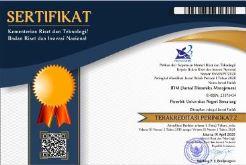Intention to Use Smartphone through Perceived Compatibility, Perceived Usefulness, and Perceived Ease of Use
Abstract
This research is aimed to test the influence of perceived compatibility perceived usefulness, perceived ease of use and intention to use smartphone using five hypotheses. Purposive sampling was used as the technique of sample collection. There are representative samples that are 92 respondents, consists of lecturers, students, and employees from AKI University in Semarang city. The data had been analyzed by using Structural Equation Modeling (SEM) and it was processed using AMOS program version 16.0. The result of the hypothesis shows that there is a positive and significant influence on perceived compatibility toward perceived usefulness, perceived compatibility toward perceived ease of use, perceived ease of use toward perceived usefulness, perceived ease of use toward intention to use. However, perceived usefulness toward intention to use is not significant. It can be caused that reason of owning smartphones is only a prestige and the users do not understand benefit of its features.
Keywords
Full Text:
PDFView Counter: Abstract - 4400 and PDF - 4380
Refbacks
- There are currently no refbacks.





